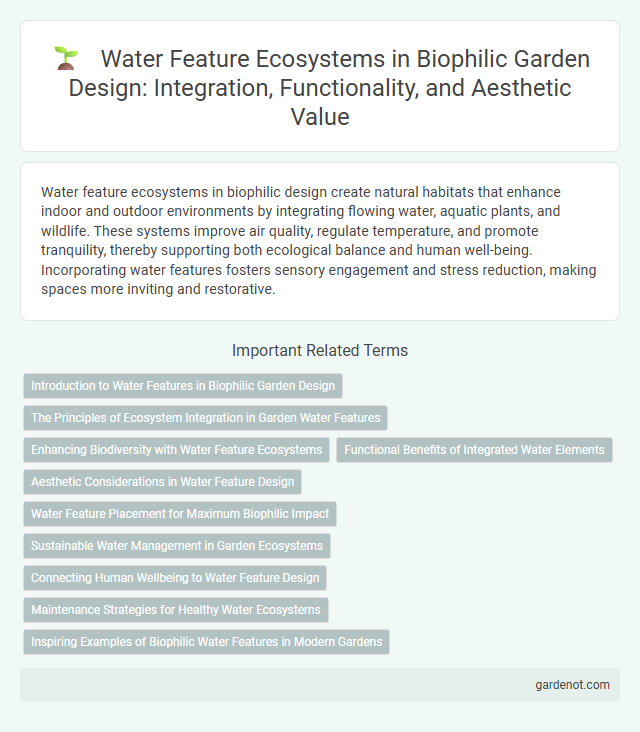Water feature ecosystems in biophilic design create natural habitats that enhance indoor and outdoor environments by integrating flowing water, aquatic plants, and wildlife. These systems improve air quality, regulate temperature, and promote tranquility, thereby supporting both ecological balance and human well-being. Incorporating water features fosters sensory engagement and stress reduction, making spaces more inviting and restorative.
Introduction to Water Features in Biophilic Garden Design
Water features in biophilic garden design enhance sensory experiences while promoting natural ecosystems by incorporating elements such as ponds, streams, and waterfalls. These features support biodiversity by attracting wildlife like birds and amphibians, contributing to a balanced microenvironment. Integrating water elements improves air quality and provides a calming auditory backdrop, essential for wellbeing and biophilic connections.
The Principles of Ecosystem Integration in Garden Water Features
In biophilic design, integrating garden water features relies on principles of ecosystem integration that promote natural balance and biodiversity. Effective water features mimic natural habitats by supporting native flora and fauna, facilitating nutrient cycling, and maintaining water quality through biological filtration. This approach enhances ecological resilience and connectivity, creating sustainable, interactive aquatic environments within landscaped spaces.
Enhancing Biodiversity with Water Feature Ecosystems
Water feature ecosystems in biophilic design significantly enhance biodiversity by providing habitats for various aquatic and terrestrial species, promoting ecological balance. These features support native flora and fauna, improving urban wildlife corridors and increasing species richness within built environments. Integrating natural water elements aids in sustaining pollinators, amphibians, and microbial diversity, crucial for resilient and thriving ecosystems.
Functional Benefits of Integrated Water Elements
Integrated water elements in biophilic design enhance indoor air quality by increasing humidity levels and reducing airborne pollutants. These water features support natural cooling effects through evaporative processes, which can lower ambient temperatures and decrease energy consumption in buildings. Biodiverse aquatic ecosystems within water features promote mental well-being by providing sensory engagement and fostering a connection with nature.
Aesthetic Considerations in Water Feature Design
Water feature design in biophilic spaces emphasizes natural aesthetics by integrating organic shapes, textures, and materials such as stone, wood, and native plants to create visually harmonious ecosystems. Reflective surfaces and gentle water movement enhance sensory appeal, promoting tranquility and connection to nature. Thoughtful placement maximizes natural light interaction and habitat support, contributing to both functional and ecological balance.
Water Feature Placement for Maximum Biophilic Impact
Strategic water feature placement enhances biophilic design by integrating natural elements that promote relaxation and wellbeing. Positioning water features near seating areas or pathways maximizes sensory engagement through sight and sound, fostering a strong connection with nature. Incorporating reflective water surfaces also amplifies natural light, improving spatial ambiance and reinforcing the ecosystem's calming effects.
Sustainable Water Management in Garden Ecosystems
Water feature ecosystems in biophilic design support sustainable water management by integrating natural filtration systems such as aquatic plants and biofilters that reduce chemical use and promote water recycling. Rainwater harvesting and greywater reuse methods within garden ecosystems minimize freshwater consumption and maintain habitat diversity for native wildlife. Implementing these strategies enhances biodiversity, improves microclimate regulation, and ensures long-term ecological balance in designed landscapes.
Connecting Human Wellbeing to Water Feature Design
Water feature ecosystems in biophilic design enhance human wellbeing by incorporating natural water elements that promote relaxation, reduce stress, and improve cognitive function. Integrating dynamic water features, such as waterfalls and streams, supports sensory engagement and fosters a calming environment that mimics natural habitats. These designs optimize indoor air quality and humidity, contributing to overall health and emotional balance.
Maintenance Strategies for Healthy Water Ecosystems
Maintenance strategies for healthy water feature ecosystems prioritize regular water quality testing to monitor pH, dissolved oxygen, and nutrient levels, preventing algae overgrowth and harmful bacteria proliferation. Implementing biological filtration systems with beneficial bacteria supports natural waste breakdown, enhancing water clarity and ecosystem balance. Routine removal of debris and periodic aquatic plant management ensure sustained oxygenation and habitat stability for diverse aquatic species.
Inspiring Examples of Biophilic Water Features in Modern Gardens
Biophilic water features in modern gardens create immersive ecosystems that enhance biodiversity and promote wellness by integrating natural elements like flowing streams, ponds with native aquatic plants, and cascading waterfalls. These designs exemplify sustainable water management by using recycled rainwater and supporting local wildlife, such as dragonflies and frogs, thereby fostering a balanced habitat. Notable examples include Singapore's Gardens by the Bay, where dynamic water features blend technology and nature, and the high-design rain gardens in urban residential landscapes that reduce runoff while providing serene, naturalistic focal points.
Water feature ecosystem Infographic

 gardenot.com
gardenot.com